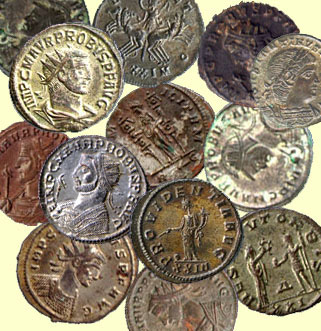
A Variety of Surfaces on Silver Plated Roman Coins After 1700 Years
All of these coins except for the one small AE4 of Constantine II were struck during the reign of the Roman emperor Probus, A.D. 276 - 282. They were collected over the years froma variety of hoards. Some were buried in sandy soil, others in clay or soil with a great deal of alkali. Others were stored in leather bags, which rotted away after a century or two. Fortumately for future collectors, a few of them were well protected in clay pots sealed up in a wall or other secure hiding place. There they were kept safe from moisture and the action of salts leached out of the soil until found by treasure hunters or construction crews in modern times. Surprisingly, many coins from the reigns of Aurelian and Probus are quite inexpensive in nice and even uncirculated condition. Most of these are nice examples, almost extremely fine condition or better even though some show the effects of corrosion. The smaller coin at the right of the photo near the top is a small AE4 (15mm) uncirculated silvered bronze piece from the reign of Constantine II (A.D. 337 - 340). It is almost as nice as these types come anc cost the author only thirty - five dollars. For a larger image of the coin see the article on Constantine II or see both obverse and reverse in the feature article on this coin.
Larger images of these and other magnificent Probus coins can be seen by visiting the Virtual Coin Dealer Gallery display entitled The Triumph of Probus.
Go back to Roman Engineering article on plating coins with silver:
Go back to Roman Coins Table of Contents:
Return to Roman Engineers Table of Contents
